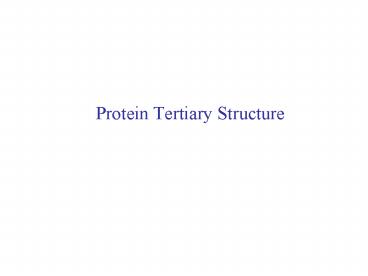Protein Tertiary Structure PowerPoint PPT Presentation
1 / 26
Title: Protein Tertiary Structure
1
Protein Tertiary Structure
2
Protein Tertiary Structure
- Packing
- helix-helix packing
- sheet-sheet packing
- helix-sheet packing
- Protein Structural Classes
- All Alpha
- All Beta
- Alpha and Beta
3
Helix Helix Packing
The Ridge-Groove model
4
Pairs of helices
W angle between the 2 axes
D distance between the two axes
5
Two types of ridges in helices
Ridge 4n
Ridge 3n
6
Ridge groove model for helix-helix packing
7
Example Helix B and G in myoglobin
8
Example Helix B and G in myoglobin
Backbone Sidechain
Backbone only
9
Sheet-Sheet Packing
- Parallel sheets tend to be covered by helices on
both sides - Anti-parallel sheets tend to have one side
covered by a sheet sandwich-type structure.
Two types of packing aligned, or orthogonal
10
Aligned sheet-sheet packing
Approx. 20 degrees between the directions of the
sheets
Sidechains are well packed
11
Orthogonal Sheet-Sheet Packing
12
Helix-Sheet Packing
- Because the periodicities of helices and strands
are different, there is not regular packing
patterns. - Helices tend to be on both sides of parallel beta
sheets.
13
Protein Architectures
- All a proteins
- All b proteins
- Alpha and beta proteins
- - a/b proteins (alternating a and b)
- - a b proteins
14
All-Alpha topologies
- The lone helix
- The helix-turn-helix motif
Glucagon (hormone involved Is regulating sugar
metabolism) PDB code 1GCN
ROP RNA-binding Protein PDB code 1ROP
The 2 helices are twisted
15
All-Alpha topologies (2)
The four helix bundle
hydrophobic
hydrophilic
16
Four helix bundle topologies
Rop dimer PDB 1ROP
Myohemerythrin PDB code 2mhr
17
All Beta Topology
Beta sandwiches
Fatty acid binding protein PDB code 1IFB
18
The Greek Key Topology
Folds including the Greek key topology include 5
to 13 strands.
19
The Greek Key Topology
Gamma crystallin. PDB code 2GCR
20
The Jellyroll Topology
A Greek key with an extra swirl
PDB code 2STV (coat protein of a virus)
21
The Beta Propellor
Seven-plated propellor Each plate is a
four-stranded anti-parallel sheet PDB code 1ERJ
22
The Beta Helix
PDB code 1EZG
Antifreeze protein from Tenebrio Molitor (beetle)
23
The Rossman Fold
Alternate beta / alpha motif Always right handed
24
The Horseshoe
PDB code 2BNH
25
The alpha/beta barrel
In a succession of alpha/beta motifs, if the
first strand Hydrogen bonds to the last, then
the structure resemble a Barrel. PDB code 1TIM
26
Summary
- Stacking of helices is best described using the
ridge-groove model. - Anti-parallel sheets tend to have one side
covered by a sheet sandwich-type structure.
Two types of packing aligned, or orthogonal. - Helices tend to be on both sides of parallel beta
sheets. - There are three main classes of proteins all
Alpha, all Beta and Alpha Beta. Sometimes, the
latter is divided in two, considering the
alternating alpha/beta proteins as defining their
own class. - Bundles are common alpha-proteins
- Common beta folds include the greek key, the
jellyroll, and sandwiches. More unusual beta
structures include the beta propeller and the
beta helix - The Rossman fold (alternating alpha/beta) is a
common motif in proteins. It is found in the
horseshoe, as well as in the TIM fold.

